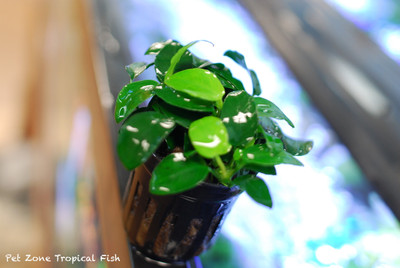Anubias in the Aquarium: A Comprehensive Guide to Cultivation and Care
Posted by Max Gandara on on 29th Feb 2024
Physical Characteristics:
Anubias plants belong to the Araceae family and are characterized by their thick, leathery leaves and rhizomatous growth pattern. The leaves are typically broad, heart-shaped, and vary in size among different Anubias species. One of the unique features of Anubias is its ability to thrive both submerged and emersed, making it a versatile choice for aquarium landscaping.
There are several popular Anubias species in the aquarium trade, including Anubias barteri, Anubias nana, Anubias coffeefolia, and Anubias congensis, each with its distinct leaf shapes and sizes.
Optimal Conditions for Growth:
Anubias is renowned for its adaptability and can thrive in a wide range of aquarium conditions. However, providing the following optimal parameters can ensure the best growth and overall health of Anubias plants:
- Lighting: Anubias prefers moderate to low lighting conditions. It can tolerate low-light environments, making it suitable for aquariums with varying light intensities. Too much direct light may lead to algae growth on the leaves.
- Temperature: Maintain a temperature range of 72°F to 82°F (22°C to 28°C). This aligns with the tropical conditions of its native habitat.
- Water Parameters: Anubias is not overly demanding when it comes to water parameters. Aim for a pH level between 6.0 to 7.5 and keep water hardness in the moderate range.
- Substrate: Anubias should not be planted in the substrate like traditional stem plants. Instead, attach it to rocks, driftwood, or other aquarium decor using thread or fishing line. This emulates its natural epiphytic growth in the wild.
- Fertilization: While Anubias can extract nutrients from the water column, supplementing with a liquid fertilizer or root tabs can help promote healthier growth. Be cautious not to overdose, as Anubias is sensitive to excessive nutrient levels.
Care Requirements:
- Substrate Attachments: When placing Anubias in the aquarium, ensure that the rhizome is not buried in the substrate. Attach the plant to rocks or driftwood, leaving the rhizome exposed. This prevents rotting and promotes optimal growth.
- Water Movement: Anubias prefers gentle water movement. Strong currents may damage the leaves, especially in larger species with broader leaves. Placing them in areas with moderate water flow is ideal.
- Pruning: Anubias requires minimal pruning. Remove any yellowing or damaged leaves with clean scissors. Avoid cutting into the rhizome, as this can lead to issues.
- Propagation: Anubias can be propagated by dividing the rhizome. Gently separate a healthy portion of the rhizome and attach it to a new substrate. Ensure each division has a portion of the rhizome and some leaves.
Creative Uses in Aquariums:
- Foreground Planting: Smaller Anubias varieties like Anubias nana can be used in the foreground to create a lush carpet effect when attached to rocks or driftwood.
- Mid-Ground Focal Points: Larger Anubias species, such as Anubias barteri, make excellent mid-ground focal points. Their robust leaves provide a contrasting texture to finer-leaved plants.
- Aquascaping Accents: Anubias attached to driftwood or rocks can serve as eye-catching accents in aquascaping layouts, creating a natural and visually appealing composition.
- Nano Tanks: Anubias is well-suited for nano tanks due to its compact size and adaptability to lower lighting conditions.
Challenges and Considerations:
- Algae Growth: Anubias leaves may be susceptible to algae growth, especially in high-light setups. Adjusting lighting levels and ensuring nutrient balance can help control algae issues.
- Snail Damage: Some aquarium snails may graze on Anubias leaves, causing damage. Regularly inspect the plant for snails, and consider adding snail-eating fish if needed.
- Rhizome Rot: Burying the rhizome in the substrate can lead to rhizome rot. Always attach Anubias to decor, leaving the rhizome above the substrate.
Anubias is a versatile and visually appealing plant that enhances the beauty of freshwater aquariums. Its adaptability, minimal care requirements, and ability to thrive in various conditions make it an excellent choice for both beginners and experienced aquarists. Whether used as a foreground carpet, mid-ground focal point, or aquascaping accent, Anubias adds a touch of natural beauty and tranquility to aquarium landscapes. By understanding its needs and implementing proper care practices, aquarists can enjoy the enduring charm of Anubias in their aquatic environments.

